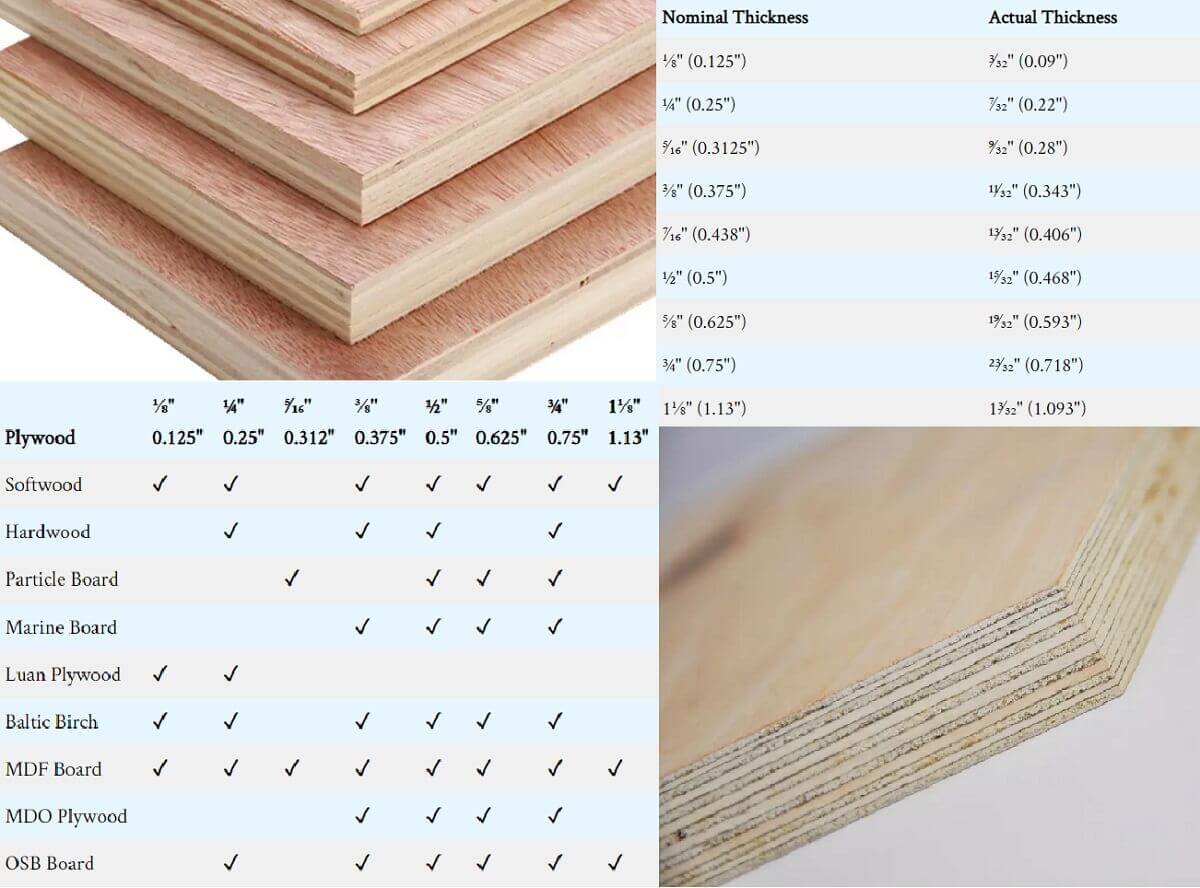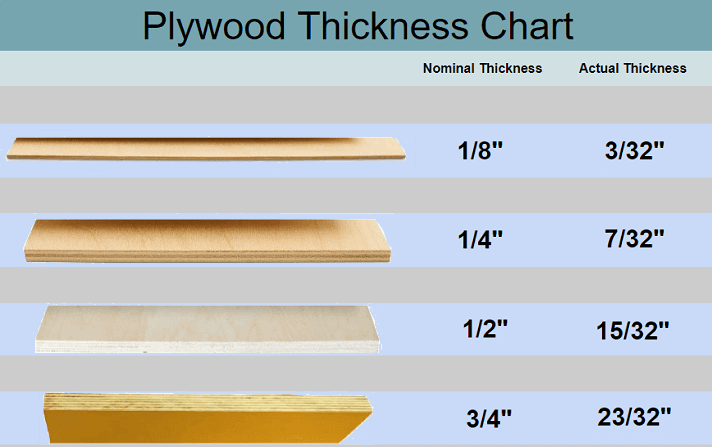If you’ve ever wondered about the size of plywood sheets, you’ve come to the right place! Plywood is a versatile building material used for various projects, from furniture to construction. But what exactly are the dimensions of plywood sheets? In this article, we’ll explore the different sizes of plywood and help you understand which one might be right for your needs. So, let’s dive in and discover the world of plywood sizes together!
When it comes to plywood, there isn’t just one standard size. Plywood sheets come in a range of sizes, catering to different requirements. From thickness to length and width, these measurements can vary depending on the intended use. So, whether you’re planning a DIY project or working on a big construction job, understanding the available sizes is essential. Get ready to uncover the answers to your plywood sizing queries!
From large sheets to smaller dimensions, plywood sizes can offer plenty of options. While some common sizes include 4 feet by 8 feet and 5 feet by 5 feet, there are also specialty dimensions available. It’s worth noting that plywood sizes may differ depending on the country or region. However, by understanding the standard sizes and their applications, you’ll be well-equipped to choose the right plywood for your next project. Let’s explore the world of plywood sizes in more detail, shall we?

The Complete Guide to Plywood Sheet Sizes: What You Need to Know
Plywood is a versatile material commonly used in construction, woodworking, and DIY projects. One of the first things to consider when working with plywood is its size. Plywood sheets come in various dimensions, and understanding these sizes is crucial for planning and executing projects effectively. In this comprehensive guide, we will explore the different sizes of plywood sheets and their applications, helping you make informed decisions for your next project.
Standard Plywood Sheet Sizes
Standard plywood sheets are typically rectangular and come in a variety of sizes. The most common size is 4 feet by 8 feet, also known as 48 inches by 96 inches. This size is widely available and used in a multitude of applications, from wall paneling to flooring to cabinetry. However, it’s important to note that plywood sheets are available in other sizes as well.
Many home improvement stores offer plywood sheets in sizes such as 4 feet by 4 feet, 2 feet by 4 feet, and even larger sizes like 5 feet by 10 feet. These alternative dimensions offer flexibility in projects where standard sizes may not fit perfectly. Whether you’re working on a large-scale construction project or a small DIY task, there is likely a plywood sheet size that will suit your needs.
Specialty Plywood Sheet Sizes
In addition to standard sizes, there are specialty plywood sheet sizes designed for specific purposes. For example, subflooring plywood is commonly available in a tongue-and-groove configuration, allowing for a more secure and seamless installation. These sheets are typically 4 feet by 8 feet, just like standard plywood sheets.
Marine plywood, on the other hand, is specifically designed for moisture resistance and is commonly used in boat building and other outdoor applications. Marine plywood sheets come in various sizes, including 4 feet by 8 feet, but may also be found in larger dimensions to accommodate bigger projects.
Custom Plywood Sheet Sizes
In certain situations, standard or specialty sizes may not meet your project’s requirements. In these cases, custom plywood sheet sizes can be ordered from manufacturers or specialty suppliers. Custom sizes allow for increased precision and eliminate the need for unnecessary cuts and waste.
When ordering custom plywood sheet sizes, it’s important to provide accurate measurements to the supplier. This ensures that the sheets are cut to your precise specifications, saving time and effort during the construction process. Keep in mind that custom sizes may come at a slightly higher cost compared to standard sizes due to the additional labor and manufacturing involved.
Choosing the Right Plywood Sheet Size
Selecting the appropriate plywood sheet size for your project depends on several factors. Consider the dimensions of the area you’re working with and determine whether standard or custom sizes would be a better fit. Additionally, take into account the specific requirements of your project. For example, if the plywood will be exposed to water or moisture, opting for marine plywood in an appropriate size would be ideal.
It’s also worth considering the transportation and handling aspect. Larger plywood sheets may require additional manpower or logistical arrangements for transportation, while smaller sheets may be easier to maneuver and fit through doorways and tight spaces.
Benefits of Standard Sizes
Standard plywood sheet sizes have several advantages. Firstly, they are widely available at most home improvement stores, making them easily accessible for various projects. Additionally, standard sizes are more cost-effective since they are produced in large quantities and readily stocked. This availability also means that it’s often easier to find matching accessories and hardware for standard-sized plywood sheets.
Custom vs. Standard Sizes: Which to Choose?
When deciding between custom and standard-sized plywood sheets, it ultimately depends on the specifics of your project. Custom sizes offer more precise fitting and minimize waste, making them a suitable choice for complex or specialized applications. However, they may come at a higher cost and may require longer lead times.
Standard sizes, on the other hand, are more readily available, often at lower prices, and cater to a wide range of applications. They are a convenient choice for many DIYers and professionals working on standard projects. Consider the requirements and constraints of your project to determine whether custom or standard-sized plywood sheets are the better option.
Optimizing Usage and Minimizing Waste
When working with plywood sheets, it’s important to optimize their usage to minimize waste and maximize cost-effectiveness. Here are a few tips to help you make the most out of your plywood sheets:
1. Accurate Measurements and Planning
Before making any cuts, carefully measure and plan your project to determine the exact dimensions and quantities of plywood sheets required. This will help you avoid unnecessary purchases and reduce waste.
2. Consider Sheathing Techniques
If you need larger dimensions than what is available in standard plywood sheet sizes, consider utilizing sheathing techniques. Sheathing involves joining multiple sheets together to create a larger surface area. This technique is commonly used in construction projects and can be efficient in maximizing material usage.
3. Utilize Offcuts and Scraps
Even after careful planning, there may still be small offcuts and scraps left over. These leftover pieces can often be repurposed for smaller projects or used as additional support or reinforcement in your main project. Think creatively and find ways to make use of these leftover materials.
In conclusion, plywood sheets come in various sizes to accommodate different projects and applications. Understanding the available sizes and their benefits can help you make informed decisions and optimize material usage. Whether you choose standard, specialty, or custom sizes, planning, accurate measurements, and efficient utilization will ensure the success of your plywood projects. Happy woodworking!
Key Takeaways: What Size Are Plywood Sheets?
– Plywood sheets come in a variety of sizes, but the most common dimensions are 4 feet by 8 feet.
– These sheets are typically available in thicknesses ranging from 1/8 inch to 1 inch.
– Other sizes may be available, such as 5 feet by 5 feet or 4 feet by 4 feet, depending on the manufacturer.
– Plywood can be cut to size if needed, making it versatile for various projects.
– It’s important to consider the intended use and load-bearing capacity when selecting the appropriate plywood sheet size.
Frequently Asked Questions
Plywood sheets come in a variety of sizes to suit different construction and woodworking needs. Here are some common questions about plywood sheet sizes:
1. What are the standard dimensions of plywood sheets?
Standard plywood sheets typically come in 4 feet by 8 feet dimensions. This means the sheets are 4 feet wide and 8 feet long. However, it’s important to note that plywood can also be found in various other dimensions, depending on the manufacturer and specific project requirements.
Some alternative sizes include 4 feet by 4 feet, 2 feet by 4 feet, and 2 feet by 2 feet sheets. These smaller sizes are often more convenient for smaller projects or if you need to transport the plywood in a smaller vehicle.
2. Are custom sizes available for plywood sheets?
Yes, custom sizes for plywood sheets are available. Many lumberyards and specialized suppliers offer cutting services, allowing you to specify the exact dimensions you need for your project. This can be particularly useful if you have specific size constraints or require non-standard dimensions for a specialized application.
Keep in mind that custom sizes may come at an additional cost and might require a minimum purchase quantity. It’s always best to check with the supplier beforehand to ensure they can accommodate your requirements.
3. What thicknesses are plywood sheets available in?
Plywood sheets are available in a range of thicknesses. Common thicknesses include 1/4 inch, 1/2 inch, 3/4 inch, and 1 inch. This variety allows for versatility in different types of construction projects, from building furniture to framing walls.
Thinner plywood sheets, such as 1/4 inch, are often used for sheathing, cabinetry, and other lightweight applications. Thicker sheets, such as 3/4 inch or 1 inch, are typically used for heavy-duty projects that require higher strength and durability.
4. Can plywood sheets be joined together for larger surfaces?
Yes, plywood sheets can be joined together to create larger surfaces. One common method is using wood glue and screws to connect the edges of two plywood sheets. This technique, known as lamination, helps ensure a secure and stable joint between the sheets.
It’s important to align the sheets properly and apply even pressure when joining them to minimize any visible seams. Additionally, reinforcing the joint with wooden splines or metal connectors can further enhance the strength and stability of the joined plywood sheets.
5. Are there alternative materials to plywood for certain applications?
Yes, there are alternative materials to plywood for certain applications. Depending on the specific project requirements and preferences, other sheet goods such as particle board, oriented strand board (OSB), and medium-density fiberboard (MDF) can be viable options.
Each material has its own advantages and disadvantages in terms of strength, appearance, and moisture resistance. It’s important to consider the specific needs of your project and consult with professionals or experts to determine the most suitable material for your particular application.

5 Mistakes Buying Plywood – Don’t Waste Your Money!
Summary
Plywood sheets come in different sizes, but the most common size is 4 feet by 8 feet. That means they are 4 feet wide and 8 feet long. Other sizes include 2 feet by 4 feet and 5 feet by 5 feet, which are also quite popular. It’s important to know the size you need before purchasing plywood for your projects.
When measuring plywood, we use two numbers: the width and the length. The width is always mentioned first, followed by the length. So if you come across a plywood sheet that is labeled as 1/2 inch by 4 feet by 8 feet, it means the plywood is half an inch thick, 4 feet wide, and 8 feet long. Understanding the different sizes of plywood sheets can help you choose the right one for your woodworking projects.
